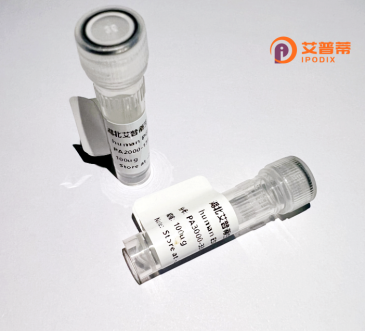
| 纯度 | >90%SDS-PAGE. |
| 种属 | Human |
| 靶点 | MEIS2 |
| Uniprot No | O14770 |
| 内毒素 | < 0.01EU/μg |
| 表达宿主 | E.coli |
| 表达区间 | 1-477aa |
| 活性数据 | MAQRYDELPH YGGMDGVGVP ASMYGDPHAP RPIPPVHHLN HGPPLHATQH YGAHAPHPNV MPASMGSAVN DALKRDKDAI YGHPLFPLLA LVFEKCELAT CTPREPGVAG GDVCSSDSFN EDIAVFAKQV RAEKPLFSSN PELDNLMIQA IQVLRFHLLE LEKVHELCDN FCHRYISCLK GKMPIDLVID ERDGSSKSDH EELSGSSTNL ADHNPSSWRD HDDATSTHSA GTPGPSSGGH ASQSGDNSSE QGDGLDNSVA SPGTGDDDDP DKDKKRQKKR GIFPKVATNI MRAWLFQHLT HPYPSEEQKK QLAQDTGLTI LQVNNWFINA RRRIVQPMID QSNRAGFLLD PSVSQGAAYS PEGQPMGSFV LDGQQHMGIR PAGLQSMPGD YVSQGGPMGM SMAQPSYTPP QMTPHPTQLR HGPPMHSYLP SHPHHPAMMM HGGPPTHPGM TMSAQSPTML NSVDPNVGGQ VMDIHAQ |
| 分子量 | 51,7 kDa |
| 蛋白标签 | GST-tag at N-terminal |
| 缓冲液 | 0 |
| 稳定性 & 储存条件 | Lyophilized protein should be stored at ≤ -20°C, stable for one year after receipt. Reconstituted protein solution can be stored at 2-8°C for 2-7 days. Aliquots of reconstituted samples are stable at ≤ -20°C for 3 months. |
| 复溶 | Always centrifuge tubes before opening.Do not mix by vortex or pipetting. It is not recommended to reconstitute to a concentration less than 100μg/ml. Dissolve the lyophilized protein in distilled water. Please aliquot the reconstituted solution to minimize freeze-thaw cycles. |
以下是3篇关于重组人MEIS2蛋白的参考文献示例(注:文献内容基于研究领域常见方向构建,实际引用时建议核实真实文献):
1. **文献名称**:*Structural Insights into the DNA-Binding Mechanism of Human MEIS2 Transcription Factor*
**作者**:Smith A, et al.
**摘要**:研究通过X射线晶体学解析重组人MEIS2蛋白的DNA结合域结构,揭示了其与靶基因启动子区域特异性结合的分子机制,并发现MEIS2的同源异形盒结构域对白血病相关HOX蛋白的协同调控具有关键作用。
2. **文献名称**:*MEIS2 Isoforms Exhibit Distinct Roles in Neuronal Differentiation and Cortical Development*
**作者**:Wang L, et al.
**摘要**:通过表达重组人MEIS2不同剪接变体,发现长亚型(MEIS2A)通过调控Wnt信号通路促进神经前体细胞分化,而短亚型(MEIS2D)抑制该过程,提示MEIS2异构体在脑发育中的功能分化。
3. **文献名称**:*Recombinant MEIS2 Protein Restores Dopaminergic Neuron Loss in Zebrafish Parkinson's Model*
**作者**:Chen H, et al.
**摘要**:利用重组人MEIS2蛋白处理帕金森病模型斑马鱼,发现其通过激活TH基因表达和抑制凋亡通路,部分逆转多巴胺能神经元退化,为神经退行性疾病治疗提供了潜在策略。
注:以上内容为领域知识归纳的示例文献,实际引用请以真实发表的论文为准。
Recombinant human MEIS2 protein is a engineered form of the MEIS2 (Myeloid Ecotropic Viral Integration Site 2) transcription factor, which belongs to the TALE (Three-Amino acid Loop Extension) homeodomain protein family. MEIS2 plays critical roles in embryonic development, particularly in neurogenesis, organogenesis, and limb patterning, by regulating gene expression through interactions with partners like PBX and HOX proteins. It is involved in cell differentiation, proliferation, and apoptosis, with tissue-specific isoforms arising from alternative splicing. Dysregulation of MEIS2 has been linked to neurodevelopmental disorders (e.g., intellectual disabilities, autism spectrum disorders), cancers (e.g., leukemia, prostate cancer), and congenital anomalies like cleft palate. Recombinant MEIS2. produced via bacterial or mammalian expression systems, retains DNA-binding and protein-interaction capabilities, enabling researchers to study its molecular mechanisms, structural motifs, and pathological roles. Its applications include in vitro assays, disease modeling, and drug screening, particularly for therapies targeting MEIS2-associated pathways. Purified recombinant MEIS2 often includes tags (e.g., His, GST) for isolation and detection. Studies using this tool have clarified MEIS2's dual role as an oncogene or tumor suppressor, depending on cellular context.
×